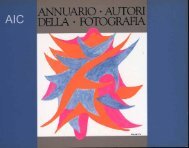ITALIANA - AIC Associazione Italiana Autori della Fotografia ...
ITALIANA - AIC Associazione Italiana Autori della Fotografia ...
ITALIANA - AIC Associazione Italiana Autori della Fotografia ...
You also want an ePaper? Increase the reach of your titles
YUMPU automatically turns print PDFs into web optimized ePapers that Google loves.
<strong>AIC</strong><br />
fece la prima tavoletta come la<br />
seconda?<br />
Perché fece ricorso per la<br />
comparazione alla riflessione<br />
nello specchio?<br />
Perché scelse come punto di<br />
vista <strong>della</strong> prima tavoletta un<br />
punto all'interno del Duomo.<br />
La possibilità del confronto<br />
consentì l'adozione del metodo<br />
dell'intersegazione come<br />
soluzione legittima del<br />
problema illusivo delle pitture<br />
che ritraevano il vero<br />
"... ma bene s'aspetti pittura<br />
quale paia molto rilevata e<br />
simigliata a chi ella ritrae<br />
qualcosa non intendo io sanza<br />
aiuto del velo alcuno mai<br />
possa".<br />
L.B. Alberti - De Pictura<br />
Quando invece il pittore<br />
costruiva non più fingendo<br />
quello che si vede ma a partire<br />
dalla propria fantasia<br />
"grandissima opera del pittore<br />
sarà l'Istoria"<br />
L.B. Alberti - De Pictura"<br />
il confronto non era più<br />
possibile.<br />
Come stabilire allora la<br />
legittimità <strong>della</strong> intersegazione?<br />
Il Brunelleschi deve avere urtato<br />
contro questa difficoltà e deve<br />
averla superata facendo ricorso<br />
al modello <strong>della</strong> visione descritto<br />
in tanti trattati di perspectiva<br />
medievali.<br />
L'occhio vi era chiamato anche<br />
camera obscura naturalis,<br />
mentre la camera obscura<br />
artificialis ne era il modello, e<br />
l'osservatore dentro la camera<br />
obscura artificiale la metafora<br />
... it was no longer possible to make a comparison.<br />
How could one then establish the validity of the intersection method?<br />
Brunelleschi must have encountered this problem, and found a solution<br />
to it by referring to the visual model described in many of the mediaeval<br />
treatises on perspective. Here, the eye was referred to as the camera<br />
obscura naturalis, while the model constituted the artificial camera<br />
obscura, and the observer inside the artificial camera obscura became<br />
the metaphor of the visual spirit in the eye which judges the likenesses<br />
that enter through the pupil.<br />
"... the process in which objects transmit their likeness, or their image in<br />
perspective, to the eye... can be demonstrated when the likenesses of the<br />
illuminated objects penetrate though a small round hole in a very dark<br />
room; then, allowing these likenesses to fall on a piece of white paper...<br />
fairly near the hole, you will see all the aforementioned ol>jects appear on<br />
the same piece of paper, but masaran minori, in other words, upside<br />
down..."<br />
Brunelleschi could have reasoned things out in the following manner: if<br />
it can be demonstrated that the painting executed by copying the image<br />
obtained in the artificial camera obscura appears like the real; then its<br />
being similar to that obtained with the intersection of the visual pyramid<br />
demonstrated that the latter appears like the real because it is similar to<br />
the image obtained by the intersection in the eye and, therefore, valid<br />
Cfig-5)<br />
"... now, I will tell you how to effect a very beautiful experiment<br />
concerning perspective. If you wish to observe how everything diminishes<br />
in Nature; not only as regards the outline of everything and every part,<br />
dello spirito visivo che<br />
nell'occhio giudica le similitudini<br />
che entrano attraverso la pupilla,<br />
"...lassperienza che mosstra<br />
liobbietti mandino loro spetie<br />
oversimilitudini intersegate<br />
dentro allocchio... si dimostra<br />
quando per alchuno picholo<br />
spiracolo rotondo penetreranno<br />
le spetie delli obbietti<br />
alluminati in abitazione forte<br />
osscura alora tu riceverai tali<br />
spetie nuna carta bianca...<br />
alquanto vicina a esso spiracholo<br />
e vedrai tutti li predetti obbietti<br />
in essa carta colle lor proprie<br />
figure masaran minori ossieno<br />
sottosopra".<br />
Il Brunelleschi può aver<br />
ragionato così: se si dimostra<br />
che la pittura costruita<br />
ricalcando l'immagine <strong>della</strong><br />
camera oscura artificiale, fa<br />
Fig. 5<br />
but also the colour, shadow and likeness, make a hole, the size of an<br />
eye-glass lens, in the shutter of a window, in the room from which you<br />
wish to look, and take a presbyopic lens... and fit it into the hole... then<br />
take a sheet of paper and hold it opposite the lens, far back enough so that<br />
you can just see the view outside over the top of it., thus, being able to see<br />
the outline of everything on the paper, you can trace all the perspective that<br />
appears there with a brush, shading and colouring it in the same delicate<br />
manner as Nature herself... " (fig. 3-6)<br />
Daniele Barbaro<br />
"La pratica <strong>della</strong> perspectiva" 1568<br />
Brunelleschi, Leonardo and Barbaro possessed the same<br />
optical-geometrical and technical knowledge, and the same techniques<br />
were available to all of them.<br />
It would therefore seem reasonable to suppose that Brunelleschi was able<br />
to:<br />
"... trace the perspective with a brush in the same manner as Nature<br />
herself... "<br />
This would explain the strange device of using a mirror to compare the<br />
first painting with the real Baptistry (fig. 1 ): the painting, which had<br />
been effected "...upside down.. ", would have had to have been rotated 18CP<br />
about its vertical axis to compare it with the real, and then seen reflected<br />
in a mirror from behind, just like a daguerrotype, which is, in fact, a<br />
positive painting created in a camera obscura<br />
The daguerrotype, like Brunelleschi's first painting, has to be turned<br />
upside down, and then turned towards the observer, if it is to be viewed









